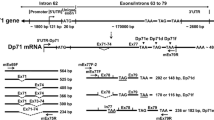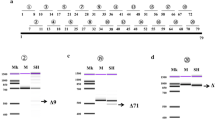Abstract
The dystonin/Bpag1 gene encodes several tissue-specific alternatively spliced transcripts that encode cytoskeletal binding proteins. These various isoforms are necessary for maintaining the structural integrity of epithelial, neural, and muscle tissues. Mutations in the dystonin/Bpag1 gene cause dystonia musculorum (dt), a hereditary neuropathy of the mouse characterized by the progressive degeneration of sensory neurons. Several dt mutant alleles exist, most of which have arisen through spontaneous mutations. In this article we demonstrate that the dt locus encodes 107 exons spanning 400 kb. The high frequency of occurrence of spontaneous dt mutants may therefore be a result of the large size of the gene. Analysis of genomic DNA from several dt spontaneous mutant alleles, dt 24J, dt 27J, dt Alb, and dt Frk, shows a deletion of the central portion of the gene in dt Alb but no large rearrangements or deletions in the other alleles. These other alleles likely have small deletions or rearrangements, or point mutations. To determine the impact of the known and unknown mutations on transcript levels, RT-PCR was performed to detect various coding regions of the dystonin/Bpag1 transcripts in brain and muscle from multiple dt alleles: dt Tg4, dt Alb, dt 24J, dt 27J, and dt Frk. With the exception of dt Frk, reduced transcript levels were observed for all alleles tested. Such alterations likely result in reduced or absent dystonin/Bpag1 protein levels. Thus, distinct genetic defects lead to a common outcome of reduced transcript expression causing the same phenotype in multiple dt alleles.



Similar content being viewed by others
References
al-Ali SY, al-Zuhair AG (1989) Fine structural study of the spinal cord and spinal ganglia in mice afflicted with a hereditary sensory neuropathy, dystonia musculorum. J Submicrosc Cytol Pathol 21: 737–748
Bernier G, Kothary R (1998) Prenatal onset of axonopathy in dystonia musculorum mice. Dev Genet 22: 160–168
Bernier G, Brown A, Dalpé G, Mathieu M, De Repentigny Y, et al. (1995) Dystonin transcripts are altered and their levels are reduced in the mouse neurological mutant dt 24J. Biochem Cell Biol 73: 605–609
Bernier G, Mathieu M, De Repentigny Y, Vidal S, Kothary R (1996) Cloning and characterization of mouse ACF7, a novel member of the dystonin subfamily of actin binding proteins. Genomics 38: 19–29
Bernier G, De Repentigny Y, Mathieu M, David S, Kothary R (1998) Dystonin is an essential component of the Schwann cell cytoskeleton at the time of myelination. Development 125: 2135–2148
Brown A, Copeland N, Gilbert D, Jenkins N, Rossant J, et al. (1994) The genomic structure of an insertional mutation in the dystonia musculorum locus. Genomics 20: 371–376
Brown A, Bernier G, Mathieu M, Rossant J, Kothary R (1995a) The mouse dystonia musculorum gene is a neural isoform of bullous pemphigoid antigen 1. Nat Genet 10: 301–306
Brown A, Dalpé G, Mathieu M, Kothary R (1995b) Cloning and characterization of the neural isoforms of human dystonin. Genomics 29: 777–780
Brunak S, Engelbrecht J, Knudsen S (1991) Prediction of human mRNA donor and acceptor sites from the DNA sequence. J Mol Biol 220: 49–65
Dalpé G, Leclerc N, Vallee A, Messer A, Mathieu M, et al. (1998) Dystonin is essential for maintaining neuronal cytoskeleton organization. Mol Cell Neurosci 10: 243–257
Dalpé G, Mathieu M, Comtois A, Zhu E, Wasiak S, et al. (1999) Dystonin–deficient mice exhibit an intrinsic muscle weakness and an instability of skeletal muscle cytoarchitecture. Dev Biol 210: 367–380
Duchen LW, Strich SJ (1964) Clinical and pathological studies of an hereditary neuropathy in mice. Brain 87: 367–378
Duchen LW, Falconer DS, Strich SJ (1963) Dystonia musculorum. A hereditary neuropathy of mice affecting mainly sensory pathways. J Physiol 165: 7–9
Elliott C, Becker B, Oehler S, Castanon M, Hauptmann R, et al. (1997) Plectin transcript diversity: identification and tissue distribution of variants with distinct first coding exons and rodless isoforms. Genomics 42: 115–125
Fuchs E, Karakesisoglou I (2001) Bridging cytoskeletal intersections. Genes Dev 15: 1–14
Fuchs P, Zorer M, Rezniczek G, Spazierer D, Oehler S, et al. (1999) Unusual 5’ transcript complexity of plectin isoforms: novel tissue–specific exons modulate actin binding activity. Hum Mol Genet 8: 2461–2472
Green K, Goldman R, Chisholm R (1988) Isolation of cDNAs encoding desmosomal plaque proteins: evidence that bovine desmoplakins I and II are derived from two mRNAs and a single gene. Proc Natl Acad Sci U S A 85: 2613–2617
Guo L, Degenstein L, Dowling J, Yu QC, Wollmann R, et al. (1995) Gene targeting of bpag1: abnormalities in mechanical strength and cell migration in stratified epithelia and neurologic degeneration. Cell 81: 233–243
Janota I (1972) Ultrastructural studies of an hereditary sensory neuropathy in mice (dystonia musculorum). Brain 95: 529–536
Jefferson J, Leung C, Liem R (2004) Plakins: goliaths that link cell junctions and the cytoskeleton. Nat Rev Mol Cell Biol 5: 542–553
Klatte DH, Kurpakus MA, Grelling KA, Jones JC (1989) Immunochemical characterization of three components of the hemidesmosome and their expression in cultured epithelial cells. J Cell Biol 109: 3377–3390
Kothary R, Clapoff S, Brown A, Campbell R, Peterson A, et al. (1988) A transgene containing lacZ inserted into the dystonia locus is expressed in neural tube. Nature 335: 435–437
Leung C, Sun D, Liem R (1999) The intermediate filament protein peripherin is the specific interaction partner of mouse BPAG1–n (dystonin) in neurons. J Cell Biol 144: 435–446
Leung CL, Zheng M, Prater SM, Liem RK (2001) The BPAG1 locus: alternative splicing produces multiple isoforms with distinct cytoskeletal linker domains, including predominant isoforms in neurons and muscles. J Cell Biol 154: 691–697
Leung C, Green K, Liem R (2002) Plakins: a family of versatile cytolinker proteins. Trends Cell Biol 12: 37–45
Mueller S, Klaus–Kovtun V, Stanley JR (1989) A 230–kD basic protein is the major bullous pemphigoid antigen. J Invest Dermatol 92: 33–38
Mutasim DF, Takahashi Y, Labib RS, Anhalt GJ, Patel HP, et al. (1985) A pool of bullous pemphigoid antigen(s) is intracellular and associated with the basal cell cytoskeleton–hemidesmosome complex. J Invest Dermatol 84: 47–53
Okumura M, Yamakawa H, Ohara O, Owaribe K (2002) Novel alternative splicings of BPAG1 (bullous pemphigoid antigen 1) including the domain structure closely related to MACF (microtubule actin cross–linking factor). J Biol Chem 277: 6682–6687
Rice P, Longden I, Bleasby A (2000) EMBOSS: the European Molecular Biology Open Software Suite. Trends Genet 16: 276–277
Sawamura D, Li K, Chu M, Uitto J (1991) Human bullous pemphigoid antigen (BPAG1). Amino acid sequences deduced from cloned cDNAs predict biologically important peptide segments and protein domains. J Biol Chem 266: 17784–17790
Stanley JR, Tanaka T, Mueller S, Klaus–Kovtun V, Roop D (1988) Isolation of complementary DNA for bullous pemphigoid antigen by use of patients’ autoantibodies. J Clin Invest 82: 1864–1870
Sun D, Leung C, Liem R (2001) Characterization of the microtubule binding domain of microtubule actin crosslinking factor (MACF): identification of a novel group of microtubule associated proteins. J Cell Sci 114: 161–172
Virata M, Wagner R, Parry D, Green K (1992) Molecular structure of the human desmoplakin I and II amino terminus. Proc Natl Acad Sci U S A 89: 544–548
Westgate GE, Weaver AC, Couchman JR (1985) Bullous pemphigoid antigen localization suggests an intracellular association with hemidesmosomes. J Invest Dermatol 84: 218–224
Yang Y, Dowling J, Yu QC, Kouklis P, Cleveland DW, et al. (1996) An essential cytoskeletal linker protein connecting actin microfilaments to intermediate filaments. Cell 86: 655–665
Yang Y, Bauer C, Strasser G, Wollman R, Julien J, et al. (1999) Integrators of the cytoskeleton that stabilize microtubules. Cell 98: 229–238
Young K, Pool M, Kothary R (2003) Bpag1 localization to actin filaments and to the nucleus is regulated by its N-terminus. J Cell Sci 116: 4543–4555
Acknowledgments
The authors thank Martine Mathieu and Yves De Repentigny for technical assistance during the course of this work. Drs. Messer and Frankel are acknowledged for their contribution of the Alb and Frk alleles of dt. The work in this study was supported by a grant from the Canadian Institutes of Health Research (CIHR). MP held a Multiple Sclerosis Society of Canada Studentship and CBL was a CIHR Postdoctoral Fellow.
Author information
Authors and Affiliations
Corresponding author
Additional information
Madeline Pool and Céline Boudreau Larivière contributed equally to this work.
Electronic Supplementary Material
Rights and permissions
About this article
Cite this article
Pool, M., Boudreau Larivière, C., Bernier, G. et al. Genetic alterations at the Bpag1 locus in dt mice and their impact on transcript expression. Mamm Genome 16, 909–917 (2005). https://doi.org/10.1007/s00335-005-0073-4
Received:
Accepted:
Published:
Issue Date:
DOI: https://doi.org/10.1007/s00335-005-0073-4




